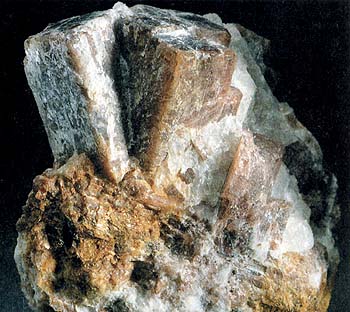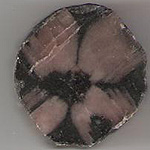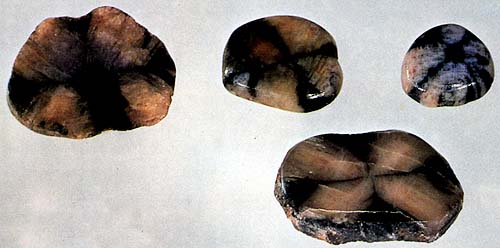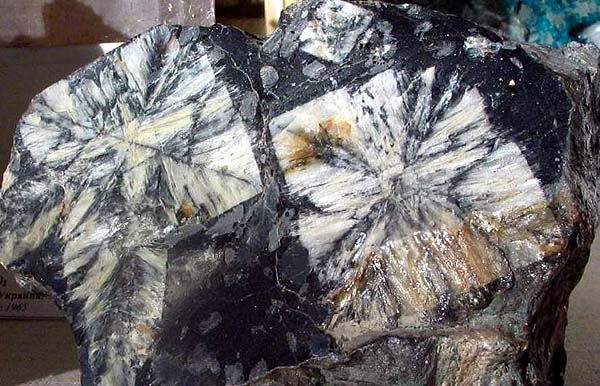Stone, minerals and semiprecious of the world stone
Silicate: Andalusite, Chiastolite -->rus
 Diagnostic cart.
Diagnostic cart.
Crystals of andalusite from Villa-di-K'yavena (Italy)
Al2 O SiO4
Crystal structure rhombic
Hardness on the Mohs scale 7,5
Specific unit weight mass 3,16-3,20
Cleavage is visible on a prism
Fracture, break wrong
Colors colourless, polycoloured (multicoloured)
Colors in powder triturate white
Glance (glitter, glare) glassy

Andalusite is a silicate of aluminium. Glance (glitter, glare) glassy or dim. Opaque. Colors: grey, pink, rose, violet, dark-green. A line is white. Fracture, break uneven. Fragile. Cleavage noperfect absolute, on the surface of verges the shallow leaves of muscovite grow often. Crystals of rhombic Crystal structure. Aggregates are grainy. Places of distribution: Tyrol (Austria), Switzerland, Spain, CIS. A chiastolite, or garden-spider, is a columnar, basaltiform variety of andalusite of rather yellow-grey or grey color with the cruciform location of shallow carbonaceous particles.
Andalusiteis a grey, pink, or brown hard mineral consisting of aluminium silicate in orthorhombic crystalline form. It occurs in metamorphic rocks and is used as a refractory and as a gemstone. Formula: Al2SiO5.
These minerals are of interest mainly for collectors; only as an exception they can come forward and in a role of jeweller stone. At treatment of andalusite which got the name at the place of find is a province Andalucia in Spain, it is necessary to take his strong pleochroism into account. Large crystals or the more so the aggregates of andalusite have jeweller quality only now and then. Glance (glitter, glare) at the mineral of glassy.
Andalusite is often presented the large crystals of prismatic type, with the small number of verges, mostly short, square in a section, as a rule, opaque. They usually meet in quartzites, gneiss, microcrystalline slates. The crystals of andalusite are often covered mica or products of the second changes. Transparent differences, suitable for the jeweller use, often corrosion outside or there are shallow pebble in sands. Unchanging andalusite, adamantine and enough heavy. It is easily divided on cleavage parallell to the prism, usually opaque and transparent.
 Oxide of aluminium (Al2O3) 63,1%, silex (SiO2) 36,9%, often there is an oxide of iron in a two-bit (Fе2O3). Form of crystalline excretions. Stolbchatye with a square section, compressed, extended prismatic. The crystals of andalusite during growth can take carbonaceous or clay material. His concentration takes a place in certain crystallography directions, as a result there is a characteristic figure of cross; such variety is named a chiastolite (Greek. "hiastos" - crossed, "lithos" - stone). Class of symmetry. Rhombo-bipyramidal group- mmm. Cleavage. Parallel an ax with, perfect absolute. Aggregates. Continuous, radiant ("sheaves"), pole, fibred, grainy.
Oxide of aluminium (Al2O3) 63,1%, silex (SiO2) 36,9%, often there is an oxide of iron in a two-bit (Fе2O3). Form of crystalline excretions. Stolbchatye with a square section, compressed, extended prismatic. The crystals of andalusite during growth can take carbonaceous or clay material. His concentration takes a place in certain crystallography directions, as a result there is a characteristic figure of cross; such variety is named a chiastolite (Greek. "hiastos" - crossed, "lithos" - stone). Class of symmetry. Rhombo-bipyramidal group- mmm. Cleavage. Parallel an ax with, perfect absolute. Aggregates. Continuous, radiant ("sheaves"), pole, fibred, grainy.
Chiastolite, or cross stone, a "garden-spider" is an opaque grey, whitish or greyish-yellow variety of andalusite. Crystals of long-prismatic, a dark cross, appearing due to electoral absorption of crystal of carbonaceous and clay particles growings verges from containing rocks, is distinctly visible in a crossrunner. Deposit of minefield mine field occurrence subsoil andalusite is known in Sonth Australia, Bolivia, Chile, France (Bretan'), Spain (Galisiya), CIS (Siberia), USA (state of Californium). A figure as a black cross in the section of crystal always came into a notice, and mineral was used mainly monks and pilgrims for making of amulets. Presently it rare collection stone. Polished trivial or slightly protuberant. Entangling him is impossible with anything.

Diagnostic indication.
If mineral to expose to the action of cathode radiation, it fluorescent in greenish-yellow tones. In Andaluzine (Spain) were found out beautiful stone, which changed the color depending on a corner under which sunbeams fallen on them. Andalusite is adopted in honour Andalucia, area of Spain, where was first found out him. Entangling him is possible with a chrysoberyl, smoke-coloured quartz, by tourmaline.
Origin provenance genesis.
Be found in rocks, exposed to contact metamorphism. Andalusite appears in metamorphic rocks (slates, gneiss), accumulates in a river alluvium. Stone, suitable for cutting, supply Brazil and Sri Lanka, and also Canada (пров. Quebec), Spain (Almeria is in Andalucia) and USA (state is Maine, Massachusetts).
Deposit minefield mine field occurrence subsoil.
Crystals are known from Andalucia (Spain, EU) and austrian Tyrol (backbone of Lizenc). In Italy, EU good russet crystals can be found in the quartzites of Villa-di-k'yavena (province of Sondrio) and in different metamorphic rocks in the area of Adamella, disposed in the province of Breshia. Found out rare rose crystals in pegmatites near Isoelly, in the underbody of Val'sesii. Svetlo-green or reddish-brown andalusite in in ten of centimetres presented a concretionх (radiantly-fibred structure) size in pegmatites in locality Due-fontane near San-dzhiovanni-morgeto (Kalabriya).
Use, practical application, deployment.
Due to that an andalusite forms large accumulations (in Russia and California), it is developed as raw material for the receipt preparation of good-refraction and acid-proof materials. Transparent differences are used on jeweller business and highly valued for magnificent pleochroism which varies from green to rose and red.

Andalusite. Andalusite. Sectoral diamond-shaped sections of andalusite (chiastolite) on the polished cut of mica slate. Keyvy, Kola peninsula, Russia (CIS). Crystals to 8 sm. A photo: © A.A. Evseev.
